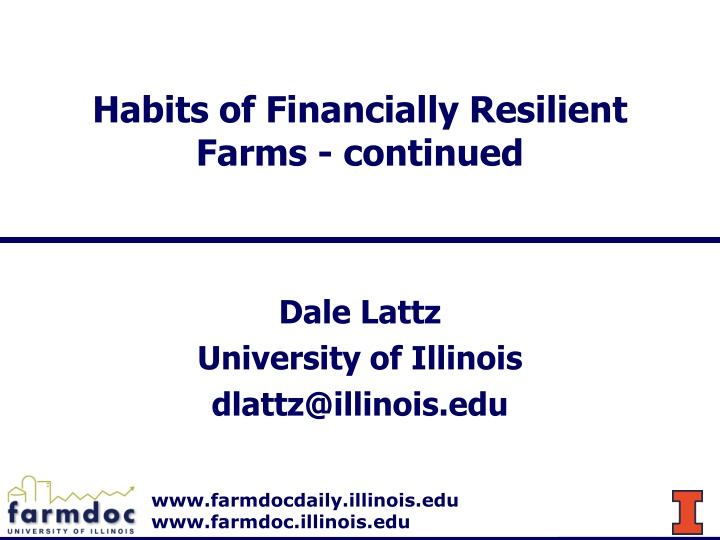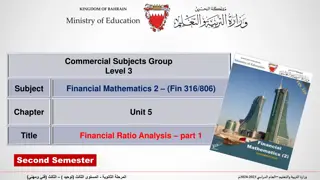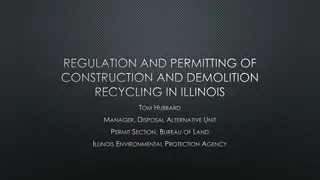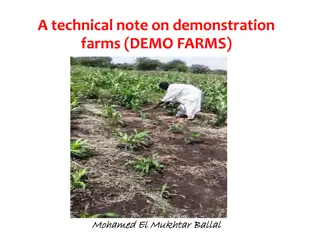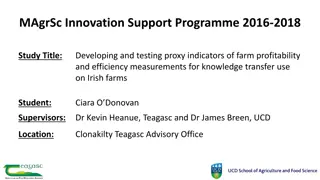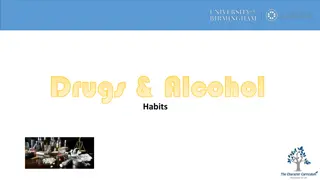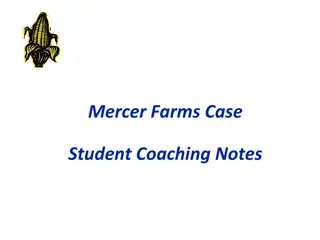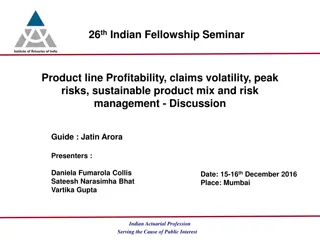Financial Resilience Habits on Illinois Farms: Insights from a Profitability Study
A study conducted on Illinois farms focuses on the financial resilience habits of successful producers, analyzing factors like farm size, labor force, tillage, planting, growing season, harvesting practices, and managerial attitudes. Survey data from 9 producers sheds light on common profitable practices, such as fall and spring tillage approaches, crop rotation strategies, and reasons behind specific planting practices.
Download Presentation

Please find below an Image/Link to download the presentation.
The content on the website is provided AS IS for your information and personal use only. It may not be sold, licensed, or shared on other websites without obtaining consent from the author.If you encounter any issues during the download, it is possible that the publisher has removed the file from their server.
You are allowed to download the files provided on this website for personal or commercial use, subject to the condition that they are used lawfully. All files are the property of their respective owners.
The content on the website is provided AS IS for your information and personal use only. It may not be sold, licensed, or shared on other websites without obtaining consent from the author.
E N D
Presentation Transcript
Habits of Financially Resilient Farms - continued Dale Lattz University of Illinois dlattz@illinois.edu www.farmdocdaily.illinois.edu www.farmdoc.illinois.edu
Follow-up survey with producers Face to face survey containing 56 questions with 9 producers in central and east central Illinois Most questions relate to the 2016 growing season Survey includes questions to get at type of production and managerial practices Goal of identifying common practices among the more profitable producers
General areas addressed Size (acres) and labor force Tillage practices Planting practices Growing season practices Harvesting practices Managerial practices Attitudinal
Size and Labor 5 farms 1,000 2,499 acres 3 farms 2,500 5,000 acres 1 farm over 5,000 acres 2 farms basically one full time equivalent for labor 3 farms 1 to 2 FTEs 3 farms 2 to 4 FTEs 1 farm 4 or more FTEs
Fall Tillage Practices Type of fall tillage for land going into soybeans 4 conventional (less than 30% residue cover) 1 reduced tillage (at least 30% residue cover) 2 no tillage 2 combination (conventional/reduced) and (reduced and no till) Type of fall tillage for land going into corn 4 no tillage 1 conventional tillage 1 strip tillage 3 combination of mainly conventional and reduced tillage
Spring Tillage Practices Type of spring tillage for land going into soybeans 4 conventional (less than 30% residue cover) 2 no tillage 1 strip tillage 2 combination (conventional/reduced) and (reduced and no till) Type of spring tillage for land going into corn 6 conventional tillage 1 strip tillage 1 no tillage 1 combination of no tillage and reduced tillage
Planting Practices All farms were in a soybeans following corn in a corn/soybean rotation Main reasons given for this were for disease and pest control, risk reduction and most profitable option Goal for wanting to start soybean planting 4 before corn planting is finished and 5 after corn planting Most would want to start planting soybeans by mid to late April Row spacing: 3 in 30 , 1 in 20 , 5 in 15 to 18 3 have separate planter for soybeans
Planting Practices - continued Only one utilized variable rate seeding technology Typical seeding rate from 120K to 150K per acre, most were 130K to 140K per acre 8 have decreased rate in last 5 years 8 used seed treatments on all acres, one on a majority of acres. All have been doing so for at least 5 years Main reasons for use of seed treatments include better emergence and planting earlier
Planting Practices - continued Ranking of reasons for selection of soybean varieties, 1 to 7 with one being most important 1.6 yield potential 2.8 herbicide resistant traits 3.1 disease resistance 3.6 seed dealer s recommendation 4.0 nematode resistance 5.5 price of seed One producer ranked company with elite genetics as his most important reason
Planting Practices - continued All planted at least a majority of Group 3 maturity, 4 planted some Group 2 and 4 planted some Group 4 4 producers planted some or all seed beans, 2 planted some or all Non-GMO beans For 2017, 8 planted some or all Roundup Ready 2 Xtend All did a pre-emergence and post-emergence weed control with 4 doing burn down in spring before soybean planting and 2 doing fall residual before soybeans on some acres 4 applied a separate fertilizer application prior to soybean planting
Growing Season Practices 6 producers routinely scouted fields themselves 6 completely or partially applied fungicide and 5 included an insecticide with the application Reasons given for fungicide application include yield gain, disease and insect control, normal practice and improve quality of seed beans to increase premiums All did grid soil sampling, 8 did used VRT for fertilizer or lime application
Harvesting Practices Harvesting soybeans was dependent on weather and crop conditions, 2 harvested all soybeans after corn was finished 3 stopped harvesting when moisture level was too low 9% to 10% 8 used a draper head 61% of soybeans commercially stored and 81% of corn commercially stored
Managerial Practices 2 producers had planted soybeans after soybeans For those that didn t, the reasons they might include changing rotations, reconfiguring a field, late spring or economics Forward pricing and the cash market were the most common forms of marketing, about 1/3 utilized hedging and options at some time Those with seed bean contracts were able to sell percentages of their crop
Managerial Practices - continued Number of producers that listed the following as their primary source of agronomic information. 9 Seed and chemical representatives 8 University specialists and Extension 5 Other farmers, neighbors and friends 4 Local businesses and retailers 4 Industry information 2 Independent crop consultants 1 Farm organizations
Managerial Practices - continued Comparison shopping for fertilizer and pesticides 4 yes, 2 no and 3 sometimes In last 5 years, how many different sources have you purchased fertilizer and pesticides from 3 used 1 supplier, 5 used 2 and 1 used 3 Comparison shopping for seed 4 yes, 3 no and 2 sometimes In last 5 years, how many different sources have you purchased seed from 3 used 2 suppliers, 2 used 3, 1 used 4 and 3 used 5
Attitudinal 8 strove for the most profitable yields levels as compared to the highest yield levels In terms of risk management strategies, all took out crop insurance coverage at 75% or greater, 5 took out hail insurance, 4 subscribed to a marketing service. 8 of the 9 felt their machinery compliment was sized correctly 6 of the 9 divided their management functions among various family members, 2 were the only operator and handled all the management functions
Attitudinal - continued Rank the following factors as how you feel they are important to the profitability of your business, 1 being the most important: 3.2 Attention to detail 3.6 Operating cost management 3.9 Maximize yields 4.3 Disciplined spending 4.4 Marketing 4.6 Machinery cost management 4.6 Land control and rent strategies 5.2 Financial planning 5.9 Overhead cost management 6.8 Implementing new technologies
Take Aways Generally typical production practices regarding tillage and rotation but 6 of the 9 were less than 30 inch row spacing, 6 had a split row planter Create additional value, 6 of the 9 raised seed beans or Non-GMO beans which created additional revenue Movement toward earlier planting of soybeans, 4 started planting soybeans before corn planting was finished Seeding rates reduced, all using some type of seed treatments
Take Aways - continued Seed selection mainly based on yield potential, herbicide use and disease resistance as compared to cost of seed Used typical marketing and risk management strategies Used newer technologies and production practices (seed treatments, draper heads, narrower rows, fungicides) but not on bleeding edge Attention to detail and cost control very important to financial success
